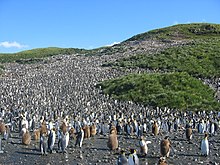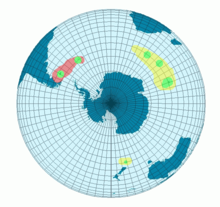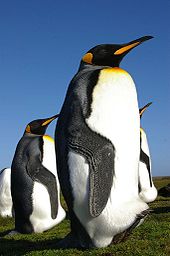King penguin
| King penguin | ||||||||||||
|---|---|---|---|---|---|---|---|---|---|---|---|---|

King penguins ( Aptenodytes patagonicus ) |
||||||||||||
| Systematics | ||||||||||||
|
||||||||||||
| Scientific name | ||||||||||||
| Aptenodytes patagonicus | ||||||||||||
| JF Miller , 1778 |
The king penguin ( Aptenodytes patagonicus ) is the second largest species of penguins (Spheniscidae) after the emperor penguin ( Aptenodytes forsteri ) and is counted together with the emperor penguin to the genus of the great penguins ( Aptenodytes ). There are currently two subspecies of the king penguin.
The population of the king penguin was classified in the IUCN Red List of Threatened Species in 2016 as “ Least Concern (LC) ” = “not endangered”.
Appearance
A fully grown king penguin reaches a body length between 85 and 95 centimeters and weighs between 10 and 16 kilograms. There is no noticeable sexual dimorphism , but females tend to be somewhat smaller and lighter. Due to the body size, it can only be confused with the emperor penguin. In this species, however, the yellow-orange plumage areas are less bright and not as clearly delimited as in the king penguin. The lower beak is also more reddish in the emperor penguin.
Adult king penguins have a black head, throat, and chin. Freshly moulted plumage has a greenish sheen. The bright yellow-orange spots on the back of the head are striking in adults. They continue as a thin line around the neck to the front chest. The top of the body is silvery gray-blue from the neck to the tail. Worn plumage shortly before moulting becomes duller and more brownish. A black, maximum one centimeter wide stripe runs from the throat to the level of the fins. The front breast is yellow-orange and brightens towards the white underbust. The rest of the underside of the body is white. The fins are white on the underside with a black tip.
The beak is between 11.4 and 13.7 inches long and very narrow. The upper beak is blackish, the lower beak is conspicuously orange for two thirds of the length in most individuals. The feet and legs are dark black-gray. The iris is brown.
Not yet sexually mature king penguins resemble the adult ones, but their yellow-orange feathers are less bright, the throat is still gray-white and the feathers on the top of the head have gray ends. They molt in the plumage of adult birds at the beginning of their third year of life. Chicks are initially feathered with gray-brown downs. They then molt into a dense, brown plumage that they wear until they are ten to twelve months old. Their beak is black.
voice
King penguins can recognize each other by their calls. The contact call is monosyllabic and lasts 0.4 to 0.8 seconds. It can be heard frequently from birds that have just gone ashore. Typically, calling king penguins point with their beak up. Sounds of the King Penguin, which play a role in courtship, are polysyllabic. Basically, a distinction can be made between two calls that differ primarily in terms of call length. The short calls can be heard especially during the pairing period and are usually called by a king penguin that has not yet been paired. The long calls can be heard especially towards the end of the courtship season, when the couple bonds already exist. They are used to find the partner bird within the colony. Threats are very short and choppy. They are usually uttered before one bird after another chops. The chicks' calls last less than half a second. Only the respective parent birds react to them. In the colonies, chicks and parent birds find each other through these contact calls.
distribution


The king penguin exists in two subspecies: Aptenodytes patagonicus patagonicus and Aptenodytes patagonicus halli . On the adjacent map, the areas marked in red correspond to the habitats of the subspecies patagonicus , the yellow zones to those of the subspecies halli . The rearing areas are marked in green. King penguins generally live in drift-free waters. All breeding colonies are north of the normal drift ice limit.
The king penguin breeds on sub-Antarctic islands between 45 and 55 ° S. Breeding colonies are for example on South Georgia , on Macquarie Island and Heard Island , Kerguelen , the Prince Edward Islands and the French Crozet Islands . The species is also represented on Marion Island . Small stocks are also found in the Falkland Islands , where they usually breed near Gentoo penguins . Regardless of their scientific name, they did not occur in Patagonia for a long time, but occasionally adult animals can be found on the Isla de los Estados during the moult . A breeding colony also existed here until around 1980, but it has now been extinct. A small colony of around 40 king penguins is currently resettling on the Strait of Magellan in Tierra del Fuego . Breeding colonies are usually found on gently sloping coastlines. The respective location is often protected and exposed to the sun. Most of the colonies can be found near the beach, but the Crozet Islands have a breeding colony 1.3 kilometers from the beach inland. Individual animals are sometimes found on the South Sandwich Islands and the South Orkney Islands .
The distribution area outside the breeding season is so far only imprecisely known. You are then likely to be in sub-Antarctic and Antarctic waters. Odd guests reach the Antarctic Peninsula , Antarctica as well as South Africa, Australia and New Zealand.
Duration
The population in the Subantarctic was estimated at around three million king penguins in 2004. The stock is now considered stable. The populations have increased in all breeding colonies in recent years after there were significant populations during the 19th and 20th centuries due to the seal hunt and the slaughter of the adult animals to extract oil from the rich fat layer. In the Falkland Islands, the species was even temporarily wiped out in 1870. Today up to 200 breeding pairs breed there again. Probably also on Heard the breeding population died out completely, the island was repopulated by king penguins around the year 1963 and has reached large population numbers again in the following years. A breeding colony on this island counted six breeding pairs in 1963. In 1988 6256 breeding pairs were counted here again. On Macquarie Island, the number of chicks counted in a breeding colony even increased 78-fold between 1930 and 1980. King penguins are currently not considered endangered, but there is a possibility in South Georgia that the fishery there could have an adverse effect on the available food supply. What was once the world's largest breeding colony of king penguins on Cochons Island in the Crozet Islands archipelago has recorded a decrease of 88 percent since 1982, and only consists of around 60,000 specimens. The reasons are unknown.
King penguins are shown in numerous large zoological gardens . European zoos that keep king penguins include those in Munich , Berlin , Wuppertal , Basel , Zurich , Vienna , Antwerp , Brest and Edinburgh .
Food and subsistence
King penguins, like all other penguins, are flightless. Their wings are transformed into narrow but powerful fins and adapted to a life in the sea. King penguins can reach diving depths of over 300 meters and stay under water for several minutes. 150 dives per day, more than half at depths of over 50 meters, are remarkable. The oxygen supply under water is ensured by myoglobin , a muscle protein related to hemoglobin. King penguins generally dive deeper during the day, while at night they stay in water regions less than 30 meters deep. Dives last an average of 5.5 minutes.
King penguins feed on small fish, krill and octopus . They can eat up to 20 kg of marine animals per hunt. Their main food areas are in the open sea. Breeding birds on Crozet Island look for food at a distance of one to thirty kilometers from the respective breeding colony during the breeding season. Individual breeding birds were also observed more than 200 kilometers from the colony. On average, the breeding birds swam 28 kilometers before diving for food for the first time.
King penguins are very sociable, hunt in groups and sometimes form large colonies with tens of thousands of animals for breeding. On land, adult king penguins have no natural enemies to fear. They only have to protect their eggs and small cubs from the occasional attack by giant petrels ( Macronectes giganteus and Macronectes halli ). The greater potential for danger lurks in the sea in the form of killer whales and leopard seals .
Reproduction
King penguins become sexually mature when they are three years old. Due to the harsh climatic conditions for rearing offspring, king penguins are strictly monogamous during a breeding cycle . A complete breeding cycle lasts almost fourteen months for the king penguins, which is why it is not possible for them to breed annually as is usual with birds. If all goes well, there will be two boys in three years. They prefer to breed on flat stretches of coast behind sandy beaches in the immediate vicinity of the sea.
The first cycle begins in November, i.e. in the early summer of the southern hemisphere, with the mating rituals . In December, the female lays a single, greenish-white egg weighing 310 grams. During the breeding season, part of the leg feathers falls out of the parents so that the egg has closer and thus warmer contact with the body. Males and females incubate it in alternation between two and three weeks for an average of 55 days in a skin fold, the non-breeding parent animal goes on extensive foraging during this time.
After hatching, the young need parental protection, care and nutrition for another nine months. In the first thirty to forty days, the young birds stay between the feet of their parents until they have grown their first down dress and they can regulate their body temperature themselves. During the rearing phase, the parents take turns at intervals of 3 to 14 days, and the chicks occasionally form cribs, then both parents go hunting. This can lead to long feeding breaks for the young, during the winter the feeding breaks can be extended to up to three months. During this time, the chicks can lose up to 70% of their body weight without being harmed.
Only after 10 to 13 months does the change from the juvenile brown down protection to the adult plumage and finally the separation of the young bird from its parents take place. The second incubation cycle begins after a phase of regeneration with the oviposition in February and the hatching of the young in April. King penguins can live up to 20 years, depending on their habitat.
research
- Intensive research on the king penguin is being carried out primarily in France at the institutes in Brest and Strasbourg. The country has particularly good access with the Crozet Islands and other sub-Antarctic territories. In any case, it is noticeable that numerically most of the scientific publications ( KVK ) on king penguins have appeared in French over the past few years.
- The “Center for Ecology and Energetic Physiology” at the University of Strasbourg researches the limits of the natural adaptability of the king penguins under the new boundary conditions of a) global overfishing and b) global warming. You have found out that a natural boundary becomes acutely threatening after about ten days. The Aptenodytes chicks simply starve to death if the parent who nourishes and protects them is not replaced by their partner for more than ten days.
- According to the French biologist and penguin specialist Pierre Jouventin, who evaluated the research institute and “Océanopolis” in Brest , their fish yield year-on-year is twice as high as the total tonnage of French fisheries. He finds it problematic that, due to the improved travel conditions, more and more people and ships land on the sub-Antarctic islands and with them more animals and plants are introduced into this ecosystem . His working group therefore strives for the environment ministry to set up a national park or an international protected area.
- The movement of king penguins on land as a function of weight was studied at the University of Roehampton in London . The penguins were watched on the treadmill. Well-fed penguins were selected and their run was analyzed again after a starvation diet. It was found that the biomechanics of the gait remained the same regardless of weight. However, fat birds were generally more wobbly on their legs, due to the weight of their belly they fell forward with almost every step, while slender animals showed safe gait.
Others
A prominent king penguin is Sir Nils Olav III. , an Honorary Norwegian Brigadier General residing in Edinburgh .
literature
- Mike Bingham: Penguins of the Falkland Islands and South America. 2001, ISBN 0-7596-3335-5 , pp. 23-28.
- Klemens Pütz : Studies on the nutritional ecology of emperor penguins (Aptenodytes forsteri) and king penguins (Aptenodytes patagonicus). Alfred Wegener Institute for Polar and Marine Research , Bremerhaven 1994, 139 p. Teilw. zugl .: Kiel, Univ., dissertation 1993.
- Bernard Stonehouse: The King Penguin, Aptenodytes patagonica, of South Georgia. Colonial Off., London 1960, Scientific reports, Falkland Islands Dependencies Survey.
- Tony D. Williams: The Penguins. Oxford University Press, Oxford 1995, ISBN 0-19-854667-X .
Web links
- French subantarctic penguins (Arte report 2001)
- Report of the 28th International Antarctic Conference SCAR in Bremen 2004
- Zoologist Kappeler talks about king penguins on the Falkland Islands
- Seasonal overview of the life of the penguins in the table. comparison
- Aptenodytes patagonicus in the endangered Red List species the IUCN 2017. Posted by: BirdLife International, 2016. Accessed November 28 of 2019.
- Videos, photos and sound recordings of Aptenodytes patagonicus in the Internet Bird Collection
- King penguins on Tierra del Fuego - (re) settlement of a (new) colony
Individual evidence
- ↑ Aptenodytes patagonicus in the endangered Red List species the IUCN 2017. Posted by: BirdLife International, 2016. Accessed November 18, 2017th
- ↑ BirdLife Factsheet on the King Penguin , accessed November 7, 2010
- ^ Williams, p. 143 and p. 144.
- ^ Williams, p. 143.
- ^ Williams, p. 146.
- ^ Williams, p. 144.
- ↑ a b c Gerald S. Tuck / Hermann Heinzel: The sea birds of the world . Ed .: Elisabeth and Friedrich Goethe. Paul Parey-Verlag, Hamburg 1980, ISBN 3-490-07818-7 .
- ^ Robin and Anne Woods: Atlas of Breeding Birds of the Falkland Islands , Anthony Nelson, Shorpshire 1997, ISBN 0-904614-60-3 , p. 28.
- ^ Williams, p. 146.
- ^ Williams, p. 144.
- ^ Williams, p. 144.
- ^ Robin and Anne Woods: Atlas of Breeding Birds of the Falkland Islands , Anthony Nelson, Shorpshire 1997, ISBN 0-904614-60-3 , pp. 28 and 29.
- ^ Williams, p. 144.
- ↑ Peter Balwin: PolarNEWS . 27th edition. No. 27 . PolarNEWS-Reisen, Basel October 2018, p. 73 .
- ^ Williams, p. 147.
- ^ Williams, p. 146.
- ↑ Fat King Penguins Are Less Steady on Their Feet . 17th February 2016.




